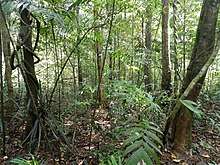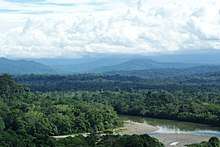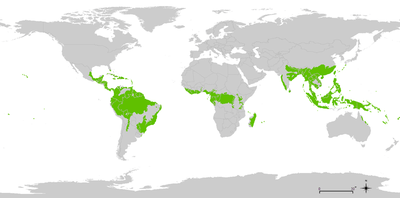Tropical rainforest conservation



Definitions
The Collins English Dictionary defines conservation as "saving and protecting the environment."[1]
The Merriam-Webster dictionary defines conservation as "a careful preservation and protection of something; especially: planned management of a natural resource to prevent exploitation, destruction, or neglect."[2]
The Merriam-Webster dictionary defines a rainforest as "a tropical woodland with an annual rainfall of at least 100 inches (254 centimeters) and marked by lofty broad-leaved evergreen trees forming a continuous canopy."[3]
69Rain Forest Conservation69 Right now, people are conserving the Tropical Rain Forests in many ways, including ecotourism and rehabilitation. Rebuilding and restarting forests in certain areas is becoming a common practice to try to increase the rain forest density. By communicating with the local people living in, and around, the rainforest, conservationists can learn more about what might allow them to best focus their conservation efforts.[4]. Rain forests globally are important to the sustainability and preservation of biodiversity. Although they may vary in location and inhabited species of plants and animals, they remain important worldwide to the production of resources and land use. It is important to take into consideration the differing species and the biodiversity that exists across different rainforest types in order to accurately implement methods of conservation.[5]×
Ecotourism
Ecotourism is conducting tours of a specific area in efforts to teach the public about often threatened environments. It is a practice that represents one imperative solution to saving endangered habitat. Tourists and tour guides alike often make generous donations to conservation efforts in the regions they visit, greatly helping the preservation of the Amazon rainforest. [6] Experts are continuously and commonly discussing with conservationists, policy‐makers, and local politicians and leaders about ecotourism and its impacts on surrounding ecosystems. [7] Ecotourism can contribute to the conservation and sustainability of biodiversity in rain forests.
Amazon Rain Forest
One of the world's largest and most dense rain forests is the Amazon rain forest in South America. Rain forests are disappearing across the world, at an alarming rate in Brazil's Amazonian rain forest. Since the 1980s, more than 153,000 square miles of Amazonian rain forest has fallen victim to deforestation.[8] Brazil has helped feed the growing global demand for food supply of soybeans and beef with the newly cleared land.[8] The Amazon easily makes up one of the world’s biggest and most biodiverse ecological reserves, once lush, think, highly diverse basin, that has now been cleared in many areas for soy fields and cattle ranches. Recently, Brazil has worked to immensely slow the destruction of its rain forests, reducing the rate of deforestation by over 80%.
Experts have effectively slowed the deforestation with several methods, by implementing regulations of stricter land use and creating areas in the Amazon that are protected by authorities.[8] Greenhouse gas emissions, which are largely due to the alarming rates of rainforest destruction, are one of the largest contributors to climate change in the Amazon region. The national government of Brazil aids better social and economic planning of specific areas with significant similarities with national policies.[9] In 2009 alone, Brazil acknowledged an issue and accepted the challenge presented to reduce its carbon emissions by 36–38 percent by 2020 in efforts to in turn reduce the amounts of gases being emitted into the air. [9]
Carbon Credits
Another way conservation has become the most economically beneficial option is through carbon credits. Under the Kyoto Protocol, countries must reduce their emissions of carbon dioxide by 5% below the 1990 levels before 2012. Countries can meet their mandatory cuts in emissions by offsetting some of those emissions some other way. Through conservation or reforestation of the rainforest, countries can receive credits.
Some worldwide companies have stated publicly that they refuse to purchase products that originate from recently cleared areas of the rainforest. Beef commonly comes from farms that are located on land previously inhabited by rainforests. [10]
It is important to conserve the rainforest because many resources for things we use everyday come from the rainforest, including rubber for tires and spices such as cinnamon and many other common items.[11] It is imperative to life on earth that the rainforest be conserved, as the trees take in carbon dioxide to provide oxygen. About a quarter of the world's greenhouse gas emissions come from deforestation and destruction of rainforests. [12]
See also
References
- ↑ "Conservation definition and meaning | Collins English Dictionary". www.collinsdictionary.com. Retrieved 2018-04-21.
- ↑ "Definition of CONSERVATION". www.merriam-webster.com. Retrieved 2018-04-21.
- ↑ "Definition of RAIN FOREST". www.merriam-webster.com. Retrieved 2018-04-21.
- ↑ Eissing, Stefanie; Amend, Thora (2008). La protección de la naturaleza es divertida: manejo de áreas protegidas y comunicación ambiental : ideas procedentes de Panamá. Eschborn: GTZ. ISBN 978-3-925064-52-4.
- ↑ Shapcott, A., Yining, L., Howard, M., Forster, P. I., Kress, W. J., Erickson, D. L., & ... McDonald, W. F. (2017). COMPARING FLORISTIC DIVERSITY AND CONSERVATION PRIORITIES ACROSS SOUTH EAST QUEENSLAND REGIONAL RAIN FOREST ECOSYSTEMS USING PHYLODIVERSITY INDEXES. International Journal Of Plant Sciences, 178(3), 211-229. doi:10.1086/690022
- ↑ Warner, E. (1991). ECOTOURISM: New Hope for Rainforests?. American Forests, 97(3/4), 37.
- ↑ STRONZA, A. (2005), HOSTS AND HOSTS: THE ANTHROPOLOGY OF COMMUNITY‐BASED ECOTOURISM IN THE PERUVIAN AMAZON. NAPA Bulletin, 23: 170-190.
- 1 2 3 Tollefson, J. (2013). A Light in the Forest. Foreign Affairs, 92(2), 141-151.
- 1 2 Ferreira, H. S., Serraglio, D. A., & Maganhati Mendes, R. L. (2016). National Policy on Climate Change and the Protection of the Amazon Forest. Environmental Policy & Law, 419-424.
- ↑ http://infoweb.newsbank.com/iw-search/we/InfoWeb?p_product=AWNB&p_theme=aggregated5&p_action=doc&p_docid=12B30BD943E41418&p_docnum=3&p_queryname=4; Provided by: Financial Times Information Limited; Index Terms: Agricultural Issues; Company News; Conservation; Environment; General News; Marketing; Greenpeace; Location(s): Brazil; Americas; Latin America; South America; Record Number: 74364647 Copyright 2009 Guardian Newspapers Ltd, Source: The Financial Times Limited
- ↑ http://www.eduplace.com/kids/sla/5/rainforest.html
- ↑ http://infoweb.newsbank.com/iw-search/we/InfoWeb?p_product=AWNB&p_theme=aggregated5&p_action=doc&p_docid=12B1150EB5B75BA8&p_docnum=5p_queryname=5; Section: NEWS; Record Number: 1791858 Copyright: Euclid Infotech Pvt. Ltd.
- Streck, Charlotte; Scholz, Sebastian M. "The Role of Forests in Global Climate Change: Whence We Come and Where We Go". International Affairs. 82: 861–879. doi:10.1111/j.1468-2346.2006.00575.x.
- Peh, Kelvin; Sodhi, Navjot; De Jong, Johnny; Sekercioglu, Cagan; Yap, Charlotte; Lim, Susan. "Conservation Value of Degraded Habitats for Forest Birds in Southern Peninsular Malaysia". Diversity Distributions. 12: 572–581. doi:10.1111/j.1366-9516.2006.00257.x.
- Coomes, Oliver; Barham, Bradford; Takasaki, Yoshito. "Targeting Conservation- Development Initiatives in Tropical Forests: Insights from Analyses of Rainforest Use and Economic Reliance among Amazonian Peasants". Ecological Economics. 51: 47–64. doi:10.1016/j.ecolecon.2004.04.004.
- Steffan-Dewenter, Ingolf; Kessler, Michael; Barkmann, Jan; Bos, Merijn; Buchori, Damayanti; Erasmi, Stefan; Faust, Heiko; Gerold, Gerhard; Glenk, Klaus; Gradstein, Robbert; Guhardja, Edi; Harteveld, Marieke; Hertel, Dietrick; Hohn, Patrick; Kappas, Martin; Köhler, Stefan; Leuschner, Christoph; Maertens, Miet; Marggraf, Rainer; Migge-Kleian, Sonja; Mogea, Johanis; Pitopang, Ramadhaniel; Schaefer, Matthias; Schwarze, Stefan; Sporn, Simone G.; Steingrebe, Andrea; Tjitrosoedirdjo, Sri S.; Tjitrosoemito, Soekisman; Twele, André; Weber, Robert; Woltmann, Lars; Zeller, Manfred; Tscharntke, Teja. "Tradeoffs Between Income, Biodiversity, and Ecosystem Functioning During Tropical Rainforest Conversion and Agroforestry Intensification". Proceedings of the National Academy of Sciences. 104: 4973–4978. doi:10.1073/pnas.0608409104. PMC 1829249. PMID 17360392.
Further reading
- Ravenel, Ramsay M.; Granoff, Ilmi M E (2004). Illegal logging in the tropics: strategies for cutting crime. New York: Haworth Press, Food Products Press. ISBN 978-1-56022-116-6.
- Friends of the Earth (1985). Tropical hardwood product list: campaign to save tropical rainforests. London: Friends of the Earth.